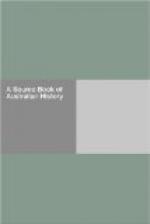For several weeks Colonel Hore, with a small garrison at Brakfontein on the Elands River, had been keeping up the connection between Mafeking and Zeerust, policing the district and forwarding on convoys to Rustenburg. At the beginning of August the force which he had for this purpose, as well as to guard a large store of supplies, consisted of 500 men, nearly all Imperial bushmen or Rhodesians, an old muzzle-loading seven-pounder, and two maxims. By this time Lord Roberts had determined that several isolated posts in the Western Transvaal, such as this one, which were in constant danger of attack, must be evacuated, and on August 1 ordered General Carrington to march to Elands River to cover Hore’s retirement. But De la Rey, with three detachments of his troops under himself, Lemmer, and Steenekemp, each numbering about 300 men, and each with a gun and a pom-pom, and a maxim, had arrived there before him, and on the morning of August 4 had aroused Hore’s camp by shell and rifle fire from the north-west, east, and south-east. The camp was on a small boulder-strewn kopje, in the centre of an amphitheatre about five acres in extent, and half a mile east of the river. Most of the men were on this central kopje, but two small hills on the bank of the river were held by detachments under Captain Butters and Lieutenant Zouch. Luckily, an attack had been expected, and stone sangars and shelters of ox-wagons had been made and further protected by biscuit boxes and bags of flour and sugar from the stores the men were guarding. Nevertheless the Boer attack seemed to have every chance in its favour; their guns were in safe positions 2,400 yards from the camp, and along the river banks they could creep close up to the defenders. Hore’s old seven-pounder, though it succeeded in silencing a Boer gun, and killed a German gunner, was very capricious in its working, and was obviously no match for the Boer guns. The thousands of horses and oxen which were in the camp under no sort of cover were nearly all killed on the first day by the Boer shells; and the stench arising from these dead animals in the narrow camp makes it almost marvellous that the men who escaped the Boer shells were not killed by pestilence. Moreover, the only chance of getting water was to take the water carts down to the river at night, and then the drivers and escort were not always safe. To make matters worse, on the second day of the siege Carrington’s advance scouts, after appearing on the rise to the west, were soon seen retiring again, so that rescue from this side seemed now out of the question. When starting, Carrington did not know that Hore was invested, so he carried very few rations. He no doubt had a small force with him and was badly off for supplies; but he had gained a ridge from which he commanded the way to Elands River, and under the circumstances of Hore’s pressing danger he was too quickly discouraged from a more determined effort to bring out the garrison. From the east another attempt was made to relieve Hore which proved equally abortive.




